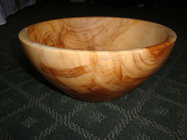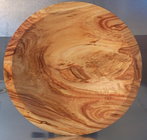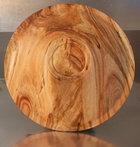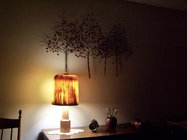We have a lot of aspen up here in the northwoods (most people call is popple around here) and I've started playing around with it. It is relatively soft and very stringy so there is a lot of tear-out. I generally turn other hardwoods with either a 40/40 grind or a sweptback gouge with a nose angle of about 50-55 degrees and get a fairly clean cut. Anyone have experience using other gouge angles/grinds on aspen?
-
It's time to cast your vote in the December 2025 Turning Challenge. (click here for details) -
Congratulations to Pat White for "Sicilian Mosaic" being selected as Turning of the Week for December 29, 2025 (click here for details) -
Welcome new registering member. Your username must be your real First and Last name (for example: John Doe). "Screen names" and "handles" are not allowed and your registration will be deleted if you don't use your real name. Also, do not use all caps nor all lower case.
You are using an out of date browser. It may not display this or other websites correctly.
You should upgrade or use an alternative browser.
You should upgrade or use an alternative browser.
Turning aspen/popple trouble
- Thread starter Brian Nowak-Thompson
- Start date
Dave Landers
Beta Tester
I just did a couple end-grain (aka spindle-orientation) hollow forms from aspen. I get best results with my spindle roughing gouge (40 deg grind), cutting with the side wing, flute up (or upside-down). Light cuts, rubbing the bevel. And it's a shearing cut, like you might get from a skew, but I find the SRG easier to control for me. Upside down sometimes gets a slightly better cut as the shavings can come off straight without having to curl around the bottom of the flute.
Haven't done many aspen bowls lately, but the same thing applies - sharp tool, light cut, shear angle. For the outside, I'd go with a pull cut using the wing of my swept-back grind gouge, bevel rubbing, with handle way down. Inside would be more trouble - probably end with a flute-up cut, which is tricky. And a bottom-bowl gouge on the bottom.
Haven't done many aspen bowls lately, but the same thing applies - sharp tool, light cut, shear angle. For the outside, I'd go with a pull cut using the wing of my swept-back grind gouge, bevel rubbing, with handle way down. Inside would be more trouble - probably end with a flute-up cut, which is tricky. And a bottom-bowl gouge on the bottom.
Having spent part of my growing up in popple country and now living and turning in aspen country, I suspect there is a difference in the wood. Not the dna, but the wood we mount on the lathe. In popple country, the trees grow 3 feet a year due to all the moisture they get. In the mountain west, an aspen tree big enough to turn is probably at least 40 years old, maybe at the end of it's life span. Popple is going to have wider growth rings, be stringy/fuzzy to turn, and maybe be more plain looking. Old mountain aspen will have a lot of black bark, maybe completely encircling the base, and the wood will have a lot of character, with knots and brown highlights, have narrower growth rings, and in my experience, be less stringy that other members of the poplar family. Mountain aspen is still a very soft, easy to turn wood, but it's also beautiful, with lots of character. (Not the best photo or shape, but here's a sample.)


Last edited:
There are lots of Aspen trees here in NW Ontario and I have turned a few pieces, depending where you cut the blanks out of the log, you can get boring or lots of color in them.
Yes it is not a wood for scrapers or steep angles on your gouge, even though I did make a couple of lamp shades out of it, and used a scraper, but it is basically engrain turning that way.
For the bowls I use the old-fashioned bowl gouge with a more acute bevel, as you do need the best sharp cutting edge, light cuts as was mentioned.
As for nice grain, this pretty well shows what you can get with judiciously selection of the blanks, in my cases, the whole tree will be firewood anyway.




Yes it is not a wood for scrapers or steep angles on your gouge, even though I did make a couple of lamp shades out of it, and used a scraper, but it is basically engrain turning that way.
For the bowls I use the old-fashioned bowl gouge with a more acute bevel, as you do need the best sharp cutting edge, light cuts as was mentioned.
As for nice grain, this pretty well shows what you can get with judiciously selection of the blanks, in my cases, the whole tree will be firewood anyway.




Dave, I'm working through some big pieces of black willow for hollow forms. It can be very hard to get a good finish on with gouges or scrapers but I can get a decent surface with my big SRG. I've read your msg a few times but can't visualize the method you're describing. Not sure I follow what you mean by upside down??I just did a couple end-grain (aka spindle-orientation) hollow forms from aspen. I get best results with my spindle roughing gouge (40 deg grind), cutting with the side wing, flute up (or upside-down). Light cuts, rubbing the bevel. And it's a shearing cut, like you might get from a skew, but I find the SRG easier to control for me. Upside down sometimes gets a slightly better cut as the shavings can come off straight without having to curl around the bottom of the flute.
Haven't done many aspen bowls lately, but the same thing applies - sharp tool, light cut, shear angle. For the outside, I'd go with a pull cut using the wing of my swept-back grind gouge, bevel rubbing, with handle way down. Inside would be more trouble - probably end with a flute-up cut, which is tricky. And a bottom-bowl gouge on the bottom.
Dave Landers
Beta Tester
Flute down. So the gouge is like ∩ rather than U. The cutting edge (side of the gouge) vs wood is basically the same in either orientation. With the flute up (what think of as normal) the shavings leaving the cut have to swoop around the bottom of the flute to be ejected out the top on the other side. But with the flute down, the shavings can fall straight away from the cut. Just a tiny bit less resistance to the cut that can be the difference sometimes.Not sure I follow what you mean by upside down??
I am almost sure it was Kirk DeHeer that I learned this from (at a club demo).
